 |
|||
| THE ATMOSPHERE OF EARTH | |||
| The atmosphere of the Earth provides the biggest clue that the planet harbours life. The large percentage of oxygen is largely the result of biological processes. The atmosphere serves to moderate the extremes of temperature on the planet, distributing heat from the equator to the poles. Earth's surface is about 30oC warmer than it would be without an atmosphere, due to the presence of small quantities of "greenhouse gases" such as water and carbon dioxide. Atmospheric composition has changed radically since the Earth was formed, and smaller changes continue today, leading to variations in the climate over hundreds of thousands of years. | |||
| Composition | |||
| The Earth's atmosphere is currently around 78% nitrogen, 20% oxygen, 1% water vapour and 1% argon. There are smaller traces of other gases, most notably 0.03% carbon dioxide. Sulphur gases are present only in trace quantities because they dissolve readily in water cloud droplets or combine to form sulphur-containing particulates. Other particulates in the lower atmosphere include silicates, sea salt, organic compounds and water (clouds and fog). | |||
 Atmospheric composition. |
 Atmospheric composition. |
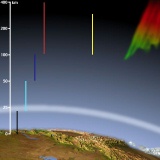 The major layers of the Earth's atmosphere. |
|
| Distribution of water vapour in the lower atmosphere (the troposphere) is highly variable due to its tendency to become liquid at moderate and low temperatures, producing clouds and precipitation. Temperature drops with increasing altitude in the troposphere by 5 to 10oC per kilometre. | |||
 The troposphere over North America at three wavelengths: clouds are seen in the visible band (left); water vapour in the mid-infrared (middle); temperature in the thermal infrared (right). |
|||
| The temperature decrease is reversed in the stratosphere, between 20 kilometres and 50 kilometres altitude, where ozone absorbs ultraviolet wavelengths. Ozone (O3) is produced when oxygen molecules (O2) are dissociated by ultraviolet light to give free oxygen atoms, which combine with other oxygen molecules. Ozone reaches a peak concentration at about 22 kilometres altitude, and this ozone layer protects all life on the surface from damaging ultraviolet radiation. It should be noted that ozone at ground level is not such a good thing - created by reactions of pollutants in sunlight, it can cause breathing difficulties and damage to health.Above 50 kilometres, in the mesosphere or middle atmosphere, temperatures again drop, to a minimum of about -90oC . Above 85 kilometres, oxygen and ozone absorption again contribute to heating, with temperature rising in the upper atmosphere, or thermosphere, and probably approaching 900oC at 350 kilometres. However, temperature at these altitudes becomes a somewhat theoretical concept due to the extremely low pressure. A satellite would not reach the temperature of the surrounding atmosphere due to the extremely low density of atmospheric particles. Satellites in low Earth orbit do, however, experience some atmospheric drag, which limits their lifetime in orbit. | |||
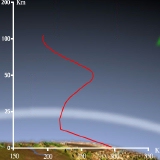 Earth's atmospheric temperature profile. |
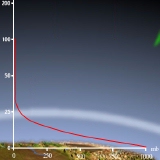 Earth's atmospheric pressure profile. |
||
| Above 100 kilometres, ultraviolet radiation, solar x-rays and cosmic rays increasingly cause ionisation - electrical charging by separating negatively-charged electrons from their parent oxygen atoms and nitrogen molecules, leaving an atom or molecule with a positive charge - an ion. The region of high electron density between 100 kilometres and 300 kilometres is termed the ionosphere. Short-wave length radio waves propagate beyond the horizon by bouncing off this electrically-conductive layer. The atmosphere we rely on today has undergone substantial changes since the formation of the Earth - changes which would not have occurred without the development of life. There are fears that the amounts of carbon dioxide released by the industrial burning of fossil fuels may upset the natural balance of carbon dioxide in the atmosphere and cause changes to the Earth's climate. | |||
| More about the evolution of the atmosphere | |||
| Meteorology | |||
| The Earth's weather systems are driven by heat exchanges between the warm equator and cold polar regions. The latitudinal temperature difference gives rise to Hadley circulation, where hot air rises in warm regions, moves at high altitudes towards colder regions, sinks and returns to the warmer regions at low level. Instability prevents a single circulation cell transporting heat from the equator to a pole, and three cells operate in each hemisphere. | |||
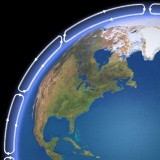 Major poleward circulation cells in the Earth's atmosphere. |
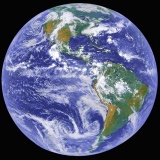 Typical 50% cloud cover across the western hemisphere of Earth. |
||
| Atmospheric water vapour rises from the oceans at the equator, releasing heat when it condenses as clusters of cumulus clouds. This released heat drives the equatorial Hadley cell. Earth's rotation produces an acceleration of air masses perpendicular to their direction of motion - the Coriolis effect - which imparts an east-west component to the north-south Hadley circulation. This component increases with increasing latitude. | |||
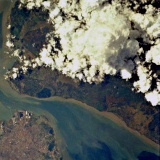 A high cumulus cloud builds over the island of Java in the afternoon. |
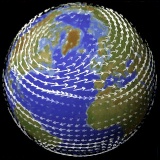 Mean ground-level winds for the northern winter. |
||
| Instabilities in the air flow result in baroclinic eddies - the progression of localised areas of low pressure (cyclones) and high pressure (anticyclones). Typically, six pairs of highs and lows girdle the Earth at mid-latitudes. They play a major role in poleward and vertical heat transport, and help maintain the jet stream of high-speed, high-altitude east-west winds. At mid latitudes, surface wind speeds are typically 2 metres per second (7 kilometres per hour), but the jet stream at 12 kilometres can be over 30 metres per second (110 kilometres per hour) | |||
 A squall line of thunderstorm clouds along a temperature front over the Atlantic Ocean. |
|||
| Stationary eddies can also arise as air moves around or over topographic features such as mountain ranges, or between areas of different temperature such as oceans and continents. The Indian monsoon weather system is due to the seasonal movement of air around the Tibetan Plateau, which brings air either from the dry continent or from the moist Indian Ocean basin. | |||
 Air flow around the Indian subcontinent in January (left) and July (right). |
 Monsoon clouds building over central India. |
 The Pacific island of Guadalupe creates a topographic wake in low-level stratus clouds. |
|
| Atmospheric water vapour will condense to clouds of liquid droplets when warm, moist air rises and cools or meets cold air at a horizontal temperature discontinuity (a front). Rising air may be due to solar heating, as at the equator or over a continent in summer, leading to cumulus clouds, or due to the presence of topographic features, leading to orographic clouds. Low pressure systems can give rise to fronts where clouds accumulate in a spiral form. | |||
 The Hawaiian island of Oahu. Clouds build as the land heats up through the day. |
 Long shadows indicate high cumulus building as moist air rises over the Andes Mountains of South America. |
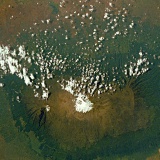 Large topographic features like Mount Kilimanjaro have their own microclimates, dominated by terrain-induced rainfall. |
|
| Particularly energetic low pressure systems can develop over the ocean basins at tropical (low) latitudes. These compact, tropical cyclones, termed hurricanes in North America or typhoons in Asia, unleash locally catastrophic forces, with winds over 35metres per second (125 kilometres per hour), high seas, heavy rainfall and flooding when they reach land. There are about 80 tropical cyclones each year, arising over the North Atlantic, Pacific and Indian Oceans. | |||
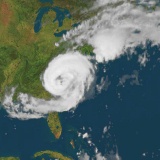 Hurricane Bonnie after its landfall on 26th August 1998. |
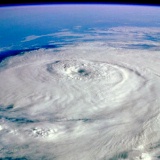 Hurricane Elena moved across the North Atlantic in August and September 1985. |
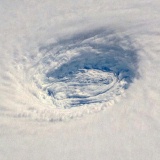 The eye of Typhoon Yuri in the western Pacific in November 1991. Wind speeds reached 270 kilometres per hour. |
|
 Hurricane Nora off the coast of Central America, September 1997. |
|||
| Climate | |||
| When the Earth's surface warms by absorption of solar energy in the form of sunlight, the peak wavelength of emission from the surface, determined by its temperature, is in the infrared. Water vapour, carbon dioxide, methane and other gases in the Earth's atmosphere block transmission of infrared radiation. Instead they absorb the energy, heating up in the process. This "greenhouse effect" keeps Earth's surface about 30oC warmer than if it had no atmosphere. This leaves the surface and lower atmosphere mostly between 0 and 30oC, where water can comfortably exist as a liquid - vital for all forms of life that we know. | |||
 The greenhouse effect. |
 Mean northern summer surface temperature for the Earth. |
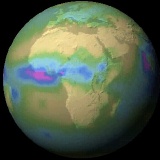 Mean northern summer precipitation for the Earth. |
|
| It is thought that atmospheric carbon dioxide levels have been fairly constant in recent Earth history. Carbon dioxide is locked into carbonate sedimentary rocks via chemical weathering, but carbonate rocks are recycled into the mantle at subduction zones and carbon dioxide is returned to the atmosphere during volcanic eruptions. A balance is thus maintained, with most of the carbon dioxide locked up in the lithospheric rocks and the oceans. This balance was not always in place, however, nor will it necessarily continue. | |||
| The sun's energy output during the early phase of Earth formation was some 10 to 20% lower than it is today. Despite this, the early Earth surface was warm enough to support liquid water and allow the development of life. High carbon dioxide levels from the planetary outgassing probably produced a strong greenhouse effect. Mountain-building as a result of plate tectonic activity exposed large areas of rock to chemical weathering, and over hundreds of millions of years carbon dioxide levels dropped and stabilised, reducing the greenhouse effect. | |||
| In comparison, Venus, closer to the sun, suffered a runaway greenhouse effect and has a surface too hot for liquid water. Mars, further away, lost most of its carbon dioxide to carbonate rocks that weren't recycled by tectonic activity and ended up with a very thin atmosphere and a surface too cold for liquid water. | |||
| Factors other than the greenhouse effect modify Earth's climate, including the orbital eccentricity, the tilt (obliquity) of the axis of rotation and the precession of the axis. These variations, on timescales of 10,000 to 100,000 years, have lead over the last few hundred million years to ice ages - periods of lower global temperatures and expanded polar and continental icecaps. An ice age is accelerated by the increased reflection of solar energy from expanded icecaps. | |||
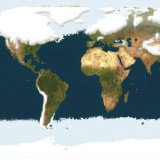 Extent of continental icecaps and sea ice during the last ice age. Note lower sea levels. |
|||
| Volcanic activity can also modify climate : while carbon dioxide emissions can cause warming by adding to the greenhouse effect, highly-reflective sulphate particles are thrown high into the stratosphere, causing cooling in the lower atmosphere. Lower temperatures where noted worldwide after the eruption of Mount Pinatubo in 1991. | |||
| Climate change may also result from mankind's activities. The increased burning of fossil fuels since the industrial revolution, in industry and cars (particularly those with catalytic converters or unleaded petrol) has added to the stock of atmospheric carbon dioxide. It is possible that this may be responsible for an observed rise in global average temperature of about half a degree Celsius over the twentieth century. | |||
| Other industrial activities have damaged the stratospheric ozone layer which protects all life on Earth from ultraviolet radiation. Chemicals used in aerosol cans and refrigerants - chloro-flourocarbons (CFCs) - are very light and very long-lived. They have accumulated in the stratosphere where they react to destroy ozone. Although the use of CFCs has been stopped in the industrialised countries, they will remain in the atmosphere for about a century, continuing to destroy ozone for decades to come. CFCs, and their replacements, HFCs, are also very powerful greenhouse gases. | |||
| More about Earth's volcanoes | |||
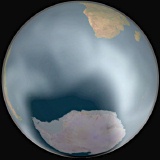 Stratospheric ozone measurements reveal very low values over the south pole during the southern spring. |
|||
|
|
|||